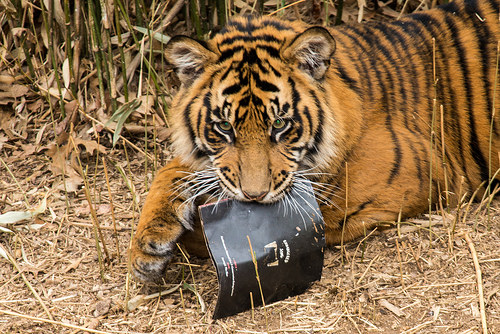Smithsonian Conservation Biology Institute and National Zoo Launches Endangered Song Project - Media Release
400 Remaining Sumatran Tigers in Existence; 400 Records Will Go Extinct if Not Shared
The Smithsonian Conservation Biology Institute and National Zoo announced today, Earth Day, the launch of the Endangered Song Project, an analog-meets-digital awareness campaign that calls upon 400 participants to use their social media strength to spread the message that there are only 400 Sumatran tigers left in the wild. The National Zoo partnered with Atlantic Records' indie rock band "Portugal. The Man" to distribute a previously unreleased song titled "Sumatran Tiger." The song was lathe-cut onto 400 custom polycarbonate records designed to degrade after a certain amount of plays. With no other copies in existence, the 400 participants are tasked with digitizing and sharing the song through their social channels with the hashtag #EndangeredSong. "Breeding" the song socially will help save it from extinction, thus raising awareness about the critically endangered Sumatran tigers and need for conservation efforts.
Created in collaboration with pro-bono services from DDB New York, an Omnicom Group, the campaign will be supported through a dedicated website, www.endangeredsong.si.edu. The site also features a real-time update of all the social conversations surrounding the project, more about the initiative and how people can help perpetuate the song.
The list of the 400 participants involved in the Endangered Song Project includes a wide range of music artists, noted bloggers, wildlife conservationists and other social media influencers who were asked to share the song, spread the message and help ignite change.
"Announcing this initiative on Earth Day is a powerful way to share our ongoing commitment to securing a future for not only wild tigers but other endangered species," said Pamela Baker-Masson, associate director of communications at the Smithsonian's National Zoological Park and Conservation Biology Institute. "As scientists explore new and innovative ways to conserve wildlife, so must we partner in new and unexpected ways to build awareness and inspire action. Simply put, our job is to save species and ensure a sustainable future for the world we share with all animals."
"Growing up in Alaska, we were surrounded by wildlife and the beauty of the natural world. We learned that we can't take these things for granted," said John Gourley of Portugal. The Man. "Thus the message of this project was very personal to us as a band, and we jumped at the chance to use our music to spread the urgent message of a species in danger of extinction."
"This project has been a terrific collaboration for DDB to lend our creative forces to a campaign bringing music and science together in a way for the Smithsonian to galvanize a new generation for conserving Sumatran tigers," said Matt Eastwood, chief creative officer of DDB New York.
With less than 400 left in the wild, Sumatran tigers are at risk of being the next subspecies of tiger to go extinct. Listed as critically endangered by the International Union for Conservation of Nature, these majestic creatures are found in forests in Sumatra. The two major threats to Sumatran tigers are habitat loss and poaching. Deforestation increases the chances of tiger -- human conflict.
The Smithsonian Conservation Biology Institute and National Zoo support conservation efforts, like the Global Tiger Initiative, which is working to double the number of wild tigers by 2022. As part of the GTI, the Smithsonian hosts courses training people charged with patrolling tiger ranges to use the latest technology to tailor their patrols around hotspots of illegal activity, work with local communities and address human-tiger conflict.
The National Zoo's Sumatran tigers participate in the Association of Zoos and Aquariums' Species Survival Plan. The SSP makes breeding recommendations for tigers in accredited zoos to preserve their genetic diversity. Those tigers serve as an insurance population for the approximately 400 wild Sumatran tigers. The National Zoo has bolstered the Sumatran tiger population in human care to date with 15 cubs.
The Smithsonian Conservation Biology Institute and National Zoo (nationalzoo.si.edu) are leaders in science, conservation and sharing knowledge to save wildlife and habitats. The living collection includes more than 1,800 animals from 300 species. Headquartered in Front Royal, Va., SCBI facilitates and promotes veterinary and reproductive research as well as conservation ecology programs based at Front Royal, the National Zoo in Washington, D.C., and at field research stations and training sites worldwide. The National Zoo and Conservation Biology Institute is a part of the Smithsonian Institution, the world's largest museum and research complex. To stay engaged with the National Zoo, visit www.facebook.com/nationalzoo, http://instagram.com/smithsonianzoo, https://twitter.com/nationalzoo and http://www.youtube.com/user/SmithsonianNZP.
Portland, Oregon via-Wasilla, Alaska-based band "Portugal. The Man" released their most recent album, Evil Friends, produced by Danger Mouse, last year. The band has grown a considerable fan base in the U.S. and worldwide through nonstop headline tours. They have played at major festivals including Coachella, Bonnaroo and Lollapalooza. Growing up in the wilderness of Alaska, lead singer John Gourley and bass player Zach Carothers developed a deep appreciation for the natural world which has heavily influenced the band's music and videos. For more information on the band, visit www.portugaltheman.com, www.facebook.com/portugaltheman, https://twitter.com/portugaltheman and http://instagram.com/portugaltheman.
Visit www.endangeredsong.si.edu for more information about becoming involved in the project.

